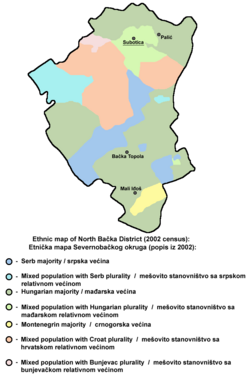Okrug Severna Bačka
| Severno-Bački okrug Северно-Бачки округ Okrug Severna Bačka Észak-bácskai körzet Sjevernobački okrug Severobáčsky okres Districtul Bačka de Nord |
|
|---|---|
| State : | Serbia |
| Part of the country : | Vojvodina |
| Capital : | Subotica |
| Municipalities : | 3 |
| Locations : | 45 |
| Area : | 1,784 km² |
| Residents : | 200,140 (2002) |
| Density : | 112.2 / km² |
|
|
|
The North Bačka ( Serbian Северно-Бачки округ or Severno-Bački okrug , Hungarian Észak-Bácskai körzet , Croatian okrug Sjevernobački , Slovak Severobáčsky okres , Romanian Districtul Backa de Nord ) or county Northern Backa is a Serb district in the northern part of Vojvodina . The administrative headquarters are in Subotica .
Communities
The district consists of three municipalities (Serbian: Opština ).
| local community | Cyrillic name | Administrative headquarters |
|---|---|---|
| Subotica | Општина Суботица | Subotica |
| Backa Topola | Општина Бачка Топола | Backa Topola |
| Mali Iđoš | Општина Мали Иђош | Mali Iđoš |
Residents
In the 2011 census , 186,906 inhabitants were counted in this district.
The ethnic distribution in the district is very mixed: Magyars (76,262), Serbs (50,472), Germans (314), Bunjewatzen , Croats , Yugoslavs and others.
The most commonly used languages are Serbian with 48% and Hungarian with 44%.
Two of the municipalities have a Magyar majority: Bačka Topola (59%) and Mali Iđoš (56%), with Subotica being fairly balanced: Magyars (38.5%), Serbs (24.1%), Bunjewatzen (11%), Croats (11%), Yugoslavs (6%), Roma (2%), Montenegrins (1%) and others.
Of the remaining villages, 20 have a Magyar majority, 15 a Serbian, seven a Bunjewatzen, a Montenegrin and two an ethnically mixed majority.
Religions and churches
Subotica is also a multi-ethnic and multi-religious center, the majority being Serbian Orthodox or Roman Catholic , but there are other religious communities in the city.
Among the churches, the Cathedral of St. Theresa (1797), the Franciscan Monastery (1723), the Orthodox church from the 18th century, the synagogue and the Orthodox church in Aleksandrovo , both from the 17th century, are worth mentioning.
economy
The food industry is strongly represented in the region, for example in the areas of meat (29 Novembar) , confectionery (Pionir) and bread and flour (Fidelinka) . Subotica is one of the cities in Serbia with the highest sales of corn , wheat and sunflower .


